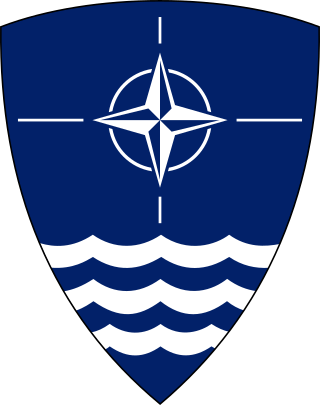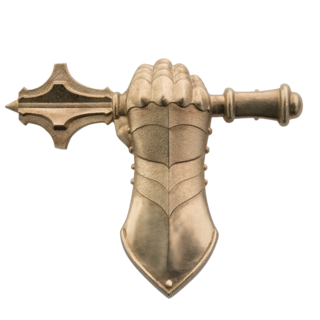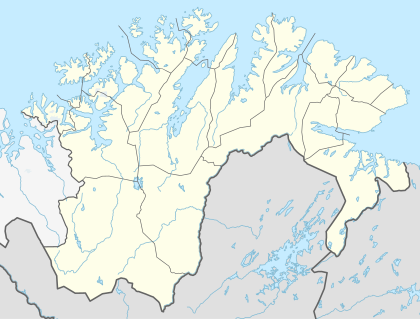This is a list of British ground forces in the Falklands War. For a list of ground forces from Argentina, see Argentine ground forces in the Falklands War
Operation Husky order of battle is a listing of the significant military and air force units that were involved in the campaign for Sicily, July 10 – August 17, 1943.

The Bulgarian Land Forces are the ground warfare branch of the Bulgarian Armed Forces. It is administered by the Ministry of Defence, previously known as the Ministry of War during the Kingdom of Bulgaria. The Land Forces were established in 1878, when they were composed of anti-Ottoman militia (opalchentsi) and were the only branch of the Bulgarian military.

The Ukrainian Marine Corps, also known simply as the Ukrainian Marines, is the maritime land force service branch of the Armed Forces of Ukraine since 2023, responsible for conducting expeditionary and amphibious operations. From its modern foundation in 1993 up to 2023 it constituted part of the Coastal Forces of the Ukrainian Navy. It is used as a component part of amphibious, airborne and amphibious-airborne operations, alone or in coordination with formations and units of the Ground Forces in order to capture parts of the seashore, islands, ports, fleet bases, coast airfields and other coast objects from the enemy. It can also be used to defend naval bases, vital shoreline areas, separate islands and coast objects, and security of hostile areas.
The Balkan Front was a military formation of the Bulgarian People's Army, intended for wartime use under the general direction of the Soviet General Staff. If a war was to have broken out between NATO and the Warsaw Pact, the bulk of the Bulgarian army would have been assigned to it.

Mechanized Infantry Forces of Ukraine are the general basis and primary combat formations of the Ukrainian Ground Forces. They execute tasks of holding the occupied areas, lines and positions tasks of enemy's impacts repelling, of penetrating the enemy's defense lines, defeating the enemy forces, capturing the important areas, lines and objectives, Capture and expel enemy forces from territory and can operate in structure of marine and landing troops.
Canadian Forces Europe was the Canadian Forces military formation in Europe during the Cold War. The CF assisted other NATO allies in watching the military activities of Warsaw Pact and the Soviet Union.
On March 1, 1984 the Italian Institute for Disarmament, Development and Peace (Istituto di ricerche per il disarmo, lo sviluppo e la pace in Rome published the entire Italian Army order of battle down to company level – this was justified by the radical party as one of its core demands was total disarmament of Europe, even though the data which was published was top secret. The Radical Party dissolved in 1989 and the IRDISP followed suit in 1990. But Radio Radicale has survived, and the OrBat can still be found today on the homepage of the radio.

The 50th Infantry Division "Regina" was an infantry division of the Royal Italian Army during World War II. The Regina was formed on 1 March 1939 in the Italian Islands of the Aegean and entitled to the Queen. After the announcement of the Armistice of Cassibile between Italy and the Allies on 8 September 1943 the division fought Wehrmacht forces in the Battle of Rhodes. The majority of the division surrendered on 11 September 1943, while the III Battalion, 10th Infantry Regiment "Regina" resisted the Germans on Leros until 16 November 1943.

Allied Forces Baltic Approaches (BALTAP) was a Principal Subordinate Command (PSC) of the NATO Military Command Structure, with responsibility for the Baltic Sea area. It was in existence from 1962 to 2002 and consisted of the Danish Armed Forces, units of the West German Bundeswehr and allied wartime reinforcements.
The Northern Army Group (NORTHAG) was a NATO military formation comprising five Army Corps from five NATO member nations. During the Cold War NORTHAG was NATO's forward defence in the Northern half of the Federal Republic of Germany (FRG). The Southern half of the Federal Republic of Germany was to be defended by the four Army Corps of NATO's Central Army Group (CENTAG). During wartime NORTHAG would command four frontline corps and one reserve corps. Air support was provided by Second Allied Tactical Air Force.
The Central Army Group (CENTAG) was a NATO military formation comprising four Army Corps from two NATO member nations comprising troops from Canada, West Germany and the United States. During the Cold War, CENTAG was NATO's forward defence in the southern half of the Federal Republic of Germany (FRG). The northern half of the FRG was defended by the four Army Corps of NATO's Northern Army Group (NORTHAG). During wartime, CENTAG would command four frontline corps. Air support was provided by Fourth Allied Tactical Air Force.

Fourth Allied Tactical Air Force was a NATO military formation under Allied Air Forces Central Europe tasked with providing air support to NATO's Central Army Group (CENTAG) in the southern portion of West Germany. 4 ATAF commanded all flying units based within its sector and all reinforcements flying into its sector, as well as ground-based radar systems and stations, air defense units and the airfields in its sector.

The Mechanized Brigade "Mantova" was a mechanized brigade of the Italian Army. Its core units were mechanized infantry battalions. The brigade's headquarters was in the city of Cividale del Friuli and all the brigade's units were based in the region of Friuli-Venezia Giulia. In 2003, the "Mantova" was raised again as a division command.

The Mechanized Division "Folgore" was a mechanized division of the Italian Army. Its core units were three mechanized brigades. The brigades headquarters was in the city of Treviso.
The following is a hierarchical outline for the Italian Army at the end of the Cold War. It is intended to convey the connections and relationships between units and formations.
Allied Forces South Norway (SONOR) was a NATO command tasked with the defense of Southern Norway. SONOR's area of responsibility included all of Norway with the adjacent sea territory excluding the three northernmost counties of Norway, which were under Allied Forces North Norway.

The Armoured Troops are the armored corps of the Ukrainian Ground Forces, the main striking force of ground troops. They are used primarily in conjunction with mechanized forces in key areas and perform the following tasks:
The following is a hierarchical outline of the Czechoslovak People's Army at the end of the Cold War. It is intended to convey the connections and relationships between units and formations. At the end of the Cold War in 1989 the Czechoslovak People's Army structure was as follows.
The following is a hierarchical outline for the Bulgarian People's Army at the end of the Cold War. It is intended to convey the connections and relationships between units and formations. At the end of the Cold War in 1989, the Bulgarian People's Army (BPA) reported to the Ministry of People's Defence (Bulgaria). The BPA included the Bulgarian Land Forces; the Air and Air Defence Forces; Navy; and Construction Troops.

















